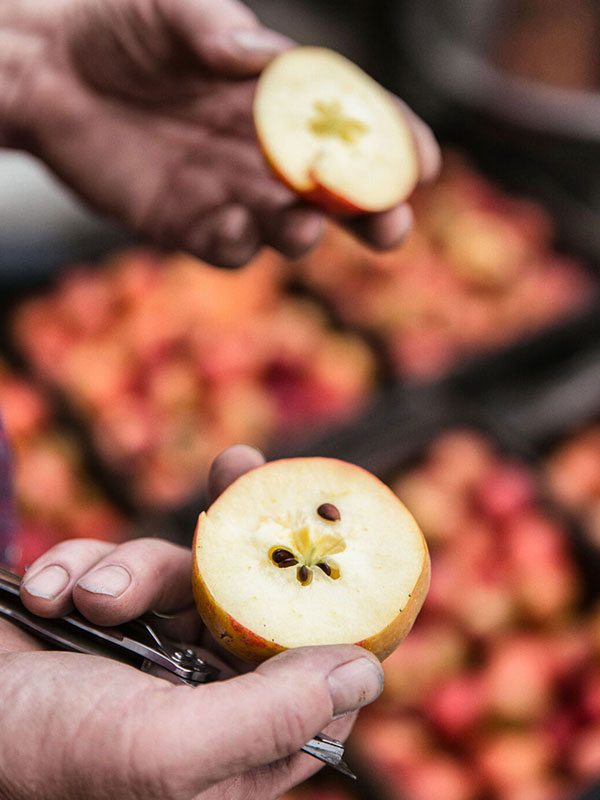The American cider scene was nascent at the turn of the 21st century, with only a few dozen cideries primarily concentrated in the Pacific Northwest and Northeast. Today, more than a thousand cideries thrive across the nation.
From 2011 to 2017, the industry experienced a nearly 500% increase in sales, fueled by significant investments from major national beer brands, especially Boston Beer Company’s Angry Orchard. Regional cider brands such as Stem, Schilling, and Blake’s have expanded their national presence, and smaller growers and producers are continuing to push the boundaries of the category.
The cider landscape continues to evolve. Makers are adapting to new apple varieties such as Cosmic Crisp, while others are turning to different fruits to craft unique co-fermented ciders to expand flavors. These cidermakers are finding utility in what might otherwise be undervalued or underutilized crops.
Cidermakers have long valued high-quality raw ingredients and the role of terroir in the finished product—there are more than 15,000 documented varieties of apples in North America. Deciding what goes into the bottle or can makes a significant difference. Each variety needs to be thoughtfully considered to build the desired cider, whether a light and breezy patio pounder drawn from culled eating apples such as Fuji or Northern Spy, or a deep, rich cask of bittersweet scrumpy made with Ellis Bitter and Porter’s Perfection by way of Western England.
All About the Apple
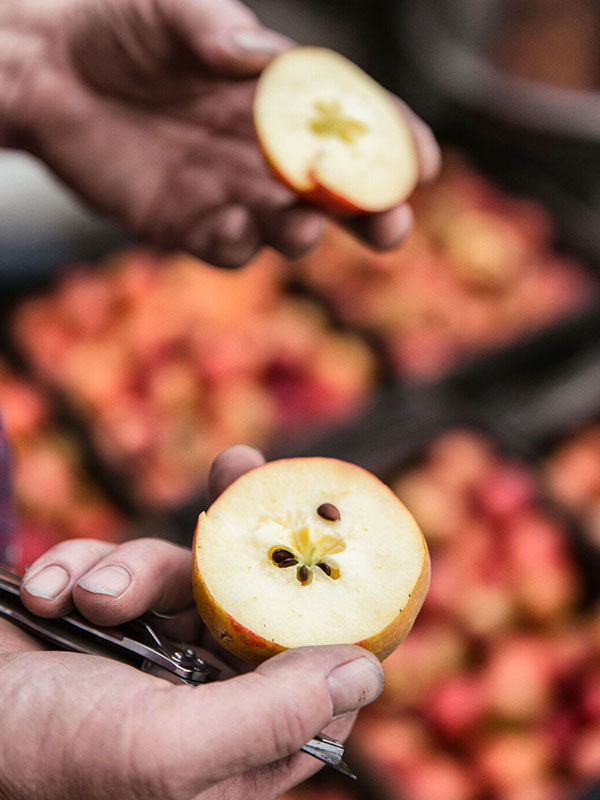
Cider has always been about fruit, but just as the beer industry has drawn from historic recipes and traditions to fuel its recent revolution, cider is expanding upon these thousands of varieties to make complex and exciting beverages. Cider’s position as the awkward sibling to beer and wine has allowed cidermakers to break convention, bend the rules, and use cider as a canvas for experimentation. Advancements in orchard management, selection, and cellar practices have raised the game for cider flavor.
Renewed interest in cider has rekindled research by both commercial and academic interests. Michigan State University’s research into red-fleshed apple genetics has helped improve the growing and fermenting of these apples. Meanwhile, the Cider Institute has helped to educate a generation of cidermakers in techniques.
Beyond these formal settings, thousands of cider experiments have helped turn cidermakers onto macerations, pet nat (naturally bubbling), malolactic fermentation, and other methods that would have been unthinkable a decade ago. Cider is now more purposeful from orchard to taste buds, with more nuanced flavors and more effective ways of communicating what is in the bottle to the consumer. Like cidermakers, brewers are also becoming more intentional in sourcing ingredients that speak not only to the style they wish to produce but to their own local foodshed and terroir.
Modern cider, found in most supermarkets nationwide and characterized by its fruit-forward, easy-drinking style, is almost exclusively made with eating apples, but has experienced continued innovation as producers pack more flavor into every quaffable can. The Pacific Northwest, with its proximity to Washington’s vast orchards, remains the heartland of this style. Around 60% of the nation’s apples are grown in Eastern Washington.
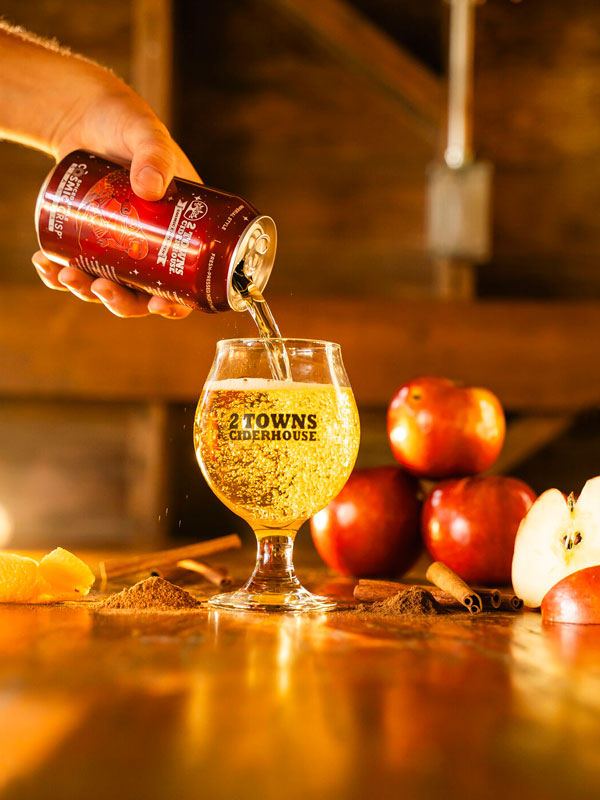
Cosmic Crisp, developed by Washington State University, was launched in 2019. Dave Takush, co-owner and head cidermaker of 2 Towns Ciderhouse in Corvallis Ore., praised Cosmic Crisp’s gooseberry and Sauvignon Blanc-like notes and its high sugar and acid content, making it ideal for fresh-fruity modern-style cider. In 2024, 2 Towns was recognized as the inaugural Cidermaker of the Year at the Great American Beer Festival.
Takush considers Cosmic Crisp a valuable addition when used alongside established varieties such as Gala, Honeycrisp, Fuji, Pink Lady, Granny Smith, Braeburn, and Golden Delicious. Even the much-maligned Red Delicious, more often associated with a mushy school cafeteria snack than a delicious treat, can contribute valuable fruity flavors and subacid components to blends.
Cosmic Crisp was only about 1% of Washington’s apple crop when it was first released. Now, it’s nearly 10%. The variety is the basis for 2 Towns’ line of imperial ciders, giving the rich, full-bodied beverages a strong backbone of flavor, texture, and aroma. Just as brewers use malt, yeast, and hops to create flavors, textures, and aromas in beer, Takush stresses that all cidermakers need to understand the varieties of apples going into their ciders.
Finding Its Own Terroir
For the last 200 years, North American apple growing has been focused on growing apples for eating. In Europe, however, tannic apples better suited for beverages than pies never went out of fashion. The first generation of American cidermakers in the 1980s, 1990s, and 2000s, such as Farnum Hill in New Hampshire, Red Barn in Washington State, and Foggy Ridge in Virginia, adopted these imports as they drew inspiration from cidermaking regions in Europe, just as mid-century California wine pioneers looked to the great regions of Bordeaux and Burgundy for varieties for their own cuvees, turning their noses at hybrids and the readily available table grapes that winemakers had used across America for centuries.
The push for growing historically tannin-rich European apple varieties in North America has seen mixed results due to differences in climate. Consequently, cidermakers are increasingly exploring indigenous apple varieties, both new and old. Winter Jon apples were once grown in the Appalachian Mountains in northern Georgia because of their late harvest and long storage capacity through the winter. Before the advent of cold and controlled atmosphere storage, these varieties were highly prized for their endurance. This full-flavor apple is a boon for Southeastern orchards struggling with a warming climate and other environmental pressures. Other varieties, such as the recently discovered seedling Nailbiter from Vermont, were found on lonely country roads, maturing without human involvement and proving to be well-suited for their environment once they reach maturity.
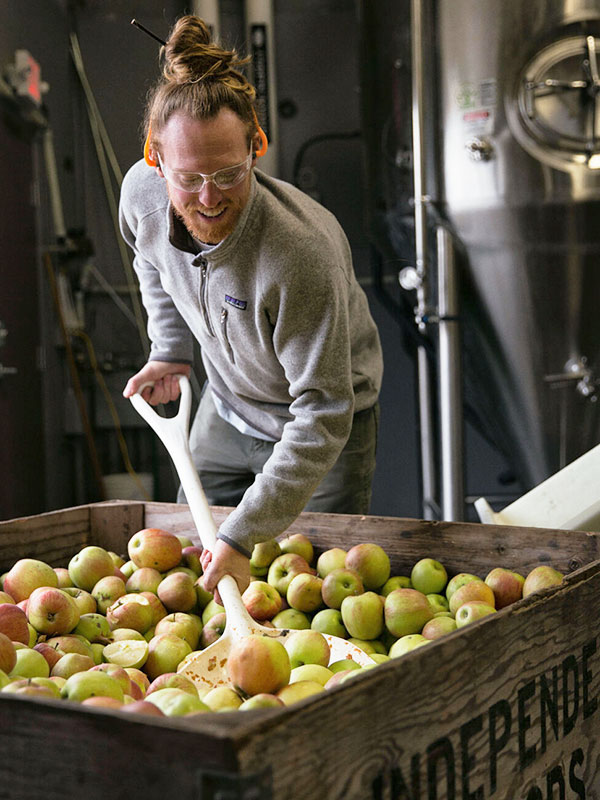
Producers of all sizes are using these new apple varieties. Stark Bro’s, one of the largest and oldest commercial nurseries, introduced the Franklin apple from Vermont in 2017, promising the desirable characteristics of European cider apples with greater resilience suited for the American climate. The apple was adopted by many growers, who continue to experiment.
The larger cider community has found itself with two camps: those making cider with eating apples and those using traditional cider apples. But that line is becoming increasingly blurred as cidermakers experiment beyond European tradition and create beverages that speak to their terroir, history, and resources. Many California wineries, facing a string of smoke-tainted grape harvests due to wildfires, have introduced cider into their portfolios. Natural wine producers such as Ashanta Wines and Horse & Plow in Sonoma County have brought their fermentation expertise to apples originally planted without any intention of becoming cider.
Varieties such as Gravenstein and Newtown Pippin are two of the most widely planted varieties in California, and while they’re top-tier eating apples, their profile as cider apples has increased as cidermakers learn to make better use of them. When treated with bâtonnage and judicious oak, Newtown Pippin can resemble Chardonnay on the nose and palate, with delicate orchard fruit and baking spice notes.
Branching Out
Rose Hill Farm was established in New York’s Hudson Valley in 1798, but its cutting-edge co-fermented ciders are anything but old-fashioned. Along with apples, the farm produces peaches, apricots, plums, cherries, and blueberries, all of which Rose Hill’s cidermaker, Matthew Sanford, transforms into exciting beverages that appeal to natural wine and farmhouse ale fans alike.
Sanford’s motto for cidermaking is clear: “If it has sugar, ferment it.” Sanford has been a proselytizer of co-ferments and using different fruits to create beverages such as Quincy, made from quince and apples, and Jerkum, a blend of apples and stone fruits such as plums, apricots, and cherries.
Sanford’s experimentation is not limited to fruit. He’s collaborated with Hudson Valley breweries such as Arrowood Farms and Plan Bee to produce Graf, a blend of cider and malt named after a similarly described beverage in Stephen King’s Dark Tower series. Graf made with Plan Bee was bottle-conditioned and disgorged, creating pearls of energy bursting with brioche and baked apple notes akin to aged Champagne—a far cry from Redd’s Hard Apple.
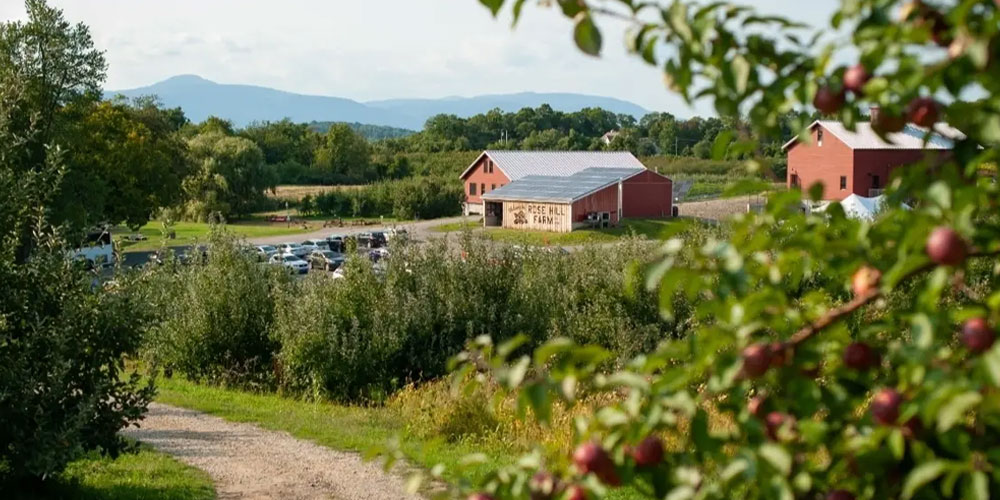
Sanford is unapologetic when it comes to taking risks in fermentation, finding new ways to use the fruit around him to create compelling beverages. Rose Hill uses both decades-old and newly planted fruit for cider, wine, and beer. Old stands of sour cherries that once drew Eastern European grandmothers to the farm every June have found their ways into other beverages. This winter Rose Hill’s cherries were used for a collaboration with Brooklyn-based Korean rice wine brewer Hana Makgeolli: Beojju, a clarified rice wine fermented with sour cherries.
A Bright Future
Cider is a dynamic and diverse category and the industry is ripe for picking. Producers are often seeking inspiration from other beverages, with the pollination of ideas from the beer, wine, and spirits industries all helping cider grow and continue its maturation. The future of cider is promising as producers and consumers increasingly prioritize quality, terroir, and sustainable practices.
Cider’s growth in the past few decades runs parallel to that of beer. A dedicated vanguard of producers and evangelists raised consumer expectations and knowledge, and there are many cidermakers who began their fermentation career with grain before making the switch to apples. Many bottles of cider were passed around the early days of craft beer as an extension of English tavern culture, where pints of cider are drawn next to ales and bitter. Revisiting those past connections can help both cider and beer grow together, through shared innovation, markets, and communication.
The rise of craft beer has changed the way that Americans engage, drink, and purchase beer. American cider has smashed past its alco-pop past but is still working to reintroduce itself to the rest of the country and build a stronger cider culture. The road is long and uncertain, but it is better together.
The post The Surge of Cider appeared first on CraftBeer.com.
